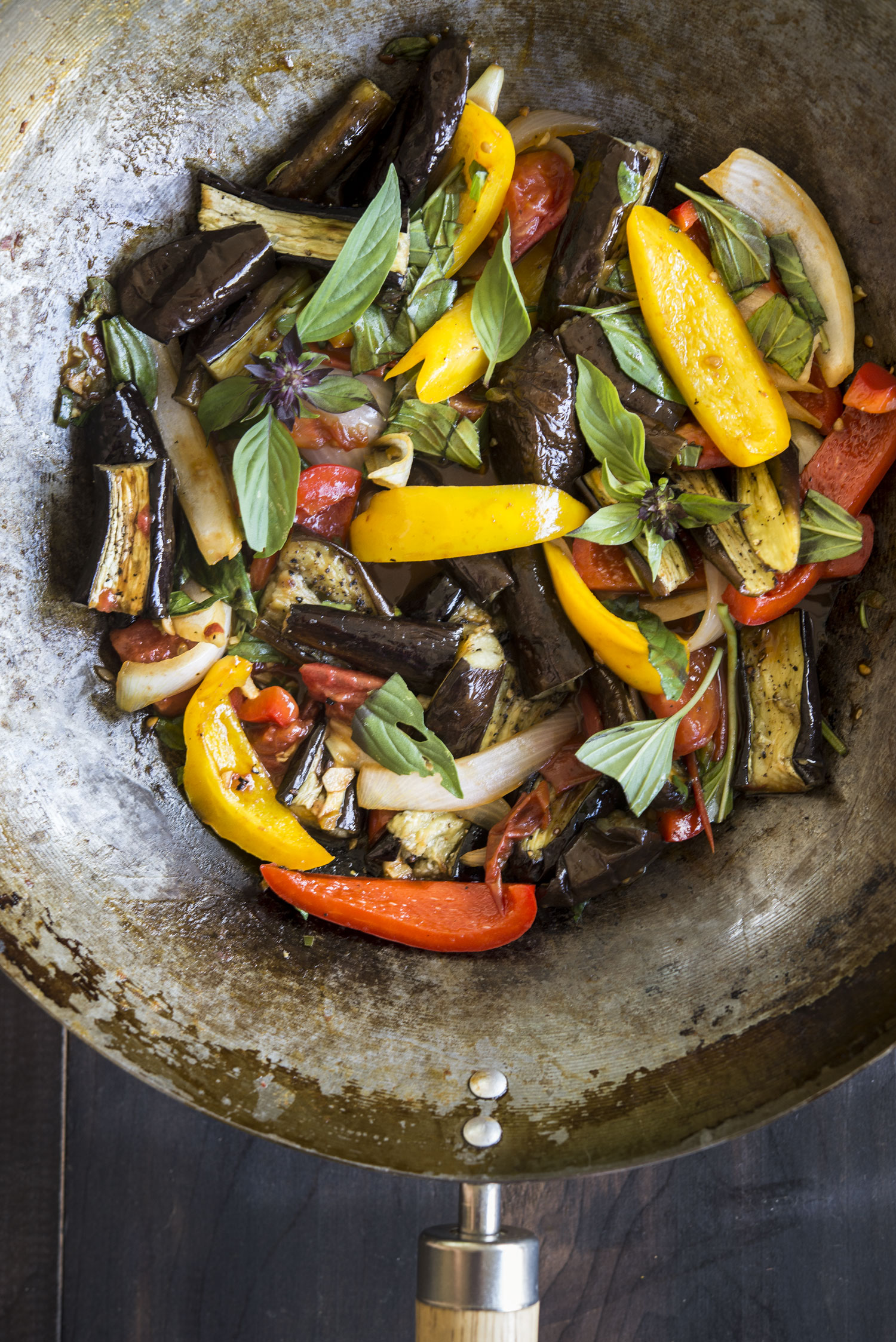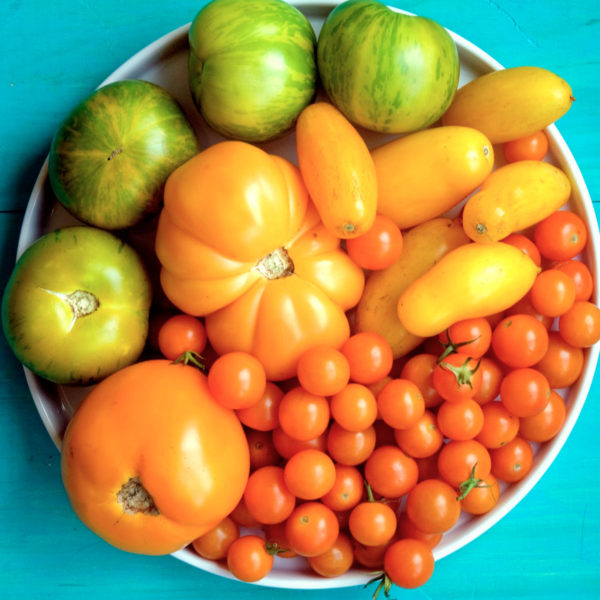Unfortunately, you won’t find these other varieties of eggplant at your typical grocery store. So, head to your local farmers’ market and explore what’s out there. All those unexpected treasures are what make cooking and eating so enjoyable.
The Japanese eggplant — the long, slender ones with the dark purple skins and stems — is by far my favorite variety. Have you tried them? When roasted or grilled, they become sweet, tender, and delicious. As an added bonus, they also have very few seeds.
With my summer cornucopia of peppers and tomatoes, had the perfect thing in mind for Japanese eggplant…
This Japanese eggplant stirfry was inspired by a dish I’ve had out in Thai restaurants. My rendition is a decidedly fresher, lighter version. All too often, eggplant dishes at Thai restaurants are overly greasy or bathed in a thick, gloppy sauce, the latter owing to excessive corn starch. Of course, eggplant is like a sponge in that it loves to soak up oil. So, what is the best way to prevent eggplant from becoming a soggy, oily mess?
Have tried several methods, stir frying the eggplant in a hot wok, pan frying in a skillet, cubing, slicing, etc., but the eggplant never seems to come out the way I want — the outside burns while the inside is undercooked (and undercooked eggplant is not good — chewy, rubbery, and bitter). Perhaps, having a high BTU burner or the like would help (alas, my stove is your standard apartment rental model).
Notwithstanding I’ve come up with a solution — that is, to first roast the eggplant in the oven. An extra step to be sure, but well worth the time and (minimal) effort.
Here’s the scoop, slice the Japanese eggplant in half lengthwise, lightly, and I stress the word lightly, toss the eggplant in olive olive, season with salt and pepper, and roast in the oven until fork tender. Then, briefly finish under the broiler for just a few minutes, until the eggplant is lightly browned on the outside.
After the eggplant is roasted, preparing the rest of the dish is a snap. It all comes together in a matter of minutes. Just heat up a wok, add the rest of the veggies and ingredients in succession, and then add the roasted and chopped eggplant. Last, finish with a nice handful of Thai basil.
This has quickly become a favorite summer dish of mine. I’ve made it at least half a dozen times in the past few weeks.
As you can see in the photo below, a nice little sauce is produced when the veggies are stir-fried in the wok with soy sauce, a hint of sugar, and the water/corn starch slurry.
The finishing touch, a healthy dose of Thai basil. Of course, if you can’t find Thai basil, substitute with Italian basil.
Japanese Eggplant Stirfry
5 Japanese Eggplant (~ 1 pound)
Sea salt and freshly ground black pepper
Extra virgin olive oil
2 cloves garlic, minced
1/2 medium onion, sliced into large wedges
1 red and/or yellow pepper, sliced into wide strips
1 medium tomato, roughly chopped
1-2 Thai or 1 serrano chile, minced (more or less depending on desired heat level)
1 small bunch basil leaves, Thai preferably (or substitute Italian)
2 tablespoons soy
1 teaspoon palm or brown sugar
1 teaspoon cornstarch + 2 tablespoon water
Preheat the oven to 450 degrees. Slice the eggplant in half lengthwise. Lightly drizzle olive oil over the eggplant and toss to evenly coat. Season with salt and pepper. Place on a baking sheet, cut side down, and bake until fork tender, about 20 to 25 minutes, flipping halfway through (so the cut side is now facing up). Place the eggplant under the broiler for 2 to 3 minutes to brown. Let cool. Cut each slice into thirds.
Add a tablespoon or two of oil to a wok. When the oil is smoking hot add the garlic and saute for 15 to 20 seconds. Add the onion and red pepper, and saute for 2 to 3 minutes. Add the tomato and saute another minute. Add the soy and sugar, and saute 1 to 2 minutes. Add the cornstarch dissolved in water. Add 2/3 of the basil leaves. Saute 1 minute. Add the reserved eggplant and toss to combine. Take off the heat. Garnish with the rest of the basil leaves. Serve warm.














2 comments
Happy Valley Chow
That stir fry looks amazing and I love all the fresh produce you used. Thanks for sharing 🙂
Happy Blogging!
Happy Valley Chow
Happy Valley Chow
That stir fry looks amazing and I love all the fresh produce you used. Thanks for sharing 🙂
Happy Blogging!
Happy Valley Chow